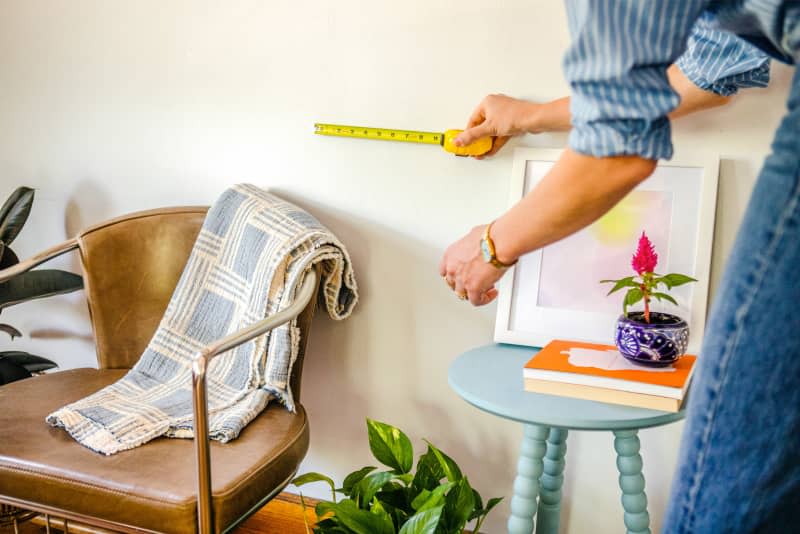Exactly What You Need to Do to Make Any Home Project Stick


Apartment Therapy’s January Cure is a free 18-day program that’ll help you reset your home for the year ahead. Sign up here and get all assignments delivered to your inbox. Joining us today is Apartment Therapy’s Home Projects Director, Megan Baker Detloff.
So far on our January Cure journey, we’ve decluttered, cleaned, and refreshed some spaces. Now, we’ll be diving into a project you’ve been meaning to check off on your to-do list.
Today’s the day we’re dedicating to the project you picked out on day four (and if you haven’t selected a project, you can do so now before we begin; consider your vision board, too!). This project could be anything! An overdue deep cleaning or decluttering task, repairing a broken item in your home, or repainting a room — there’s a lot that can be done, and we have just the expert to lean on when it comes to tackling any home project.
Apartment Therapy’s Home Projects Director, Megan Baker Detloff, is here to help set you up for success with advice on how to get your project off the ground and in motion.
Take it away, Megan!
Day 10: Work on your project.
You know the cliché: The hardest part of any project is getting started. Listen, it’s a cliché for a reason — tackling a big, multi-part challenge is intimidating, and it’s easy to get lost in nerves about how complicated, expensive, or time-consuming the whole thing will be. But if you’ve made it to this stage of the Cure, you’ve already taken some baby steps toward completing your project. Really!
If your home is anything like mine, it is just packed to the brim with potential projects, from big ones (replacing damaged flooring) to small ones (reattaching felt pads to the bottoms of our dining chairs). Listing them all out will help you get a handle on exactly how many you have — and you already did that (hello, day four). I find it helpful, too, to label the projects by size — big, medium, small — so I can focus my attention on something I actually have the energy and bandwidth to tackle.
Once you’ve figured out how much of a project you can handle right now, and which project you want to take on, it’s time to get into the nitty-gritty of today’s task. Get a fresh sheet of paper and write down your project at the top — let’s say it’s repainting the bathroom. That’s a big task! Good for you!
Let’s break that big task down into pieces. What needs to happen to repaint the bathroom? Your mini-tasks might look something like the following:
Repaint the Bathroom
Pick the color.
Assemble tools and materials.
Take art off the walls.
Dust walls.
Put down a drop cloth.
Tape off the edges of the walls.
Prime the walls.
Paint the walls.
Make sure to include a line for gathering your tools and materials. No piece of the project is too small to call out here. Now that you have a broken-down list, it’s easier to pick apart what tools and materials you’ll need to accomplish each piece of this larger task. Write those down, too.
Pick the color: paint chips and samples
Assemble tools and materials
Take art off the walls: a hammer to remove nails, a place to put the art while painting
Dust walls: dusting cloth, step ladder
Put down a drop cloth: three drop cloths — one for the floor, one to cover the vanity, and one for the toilet
Tape off edges of the walls: painter’s tape, step ladder
Prime the walls: primer, paint roller, paintbrush, paint tray, step ladder
Paint the walls: paint, paint roller, paintbrush, paint tray, step ladder
Don’t forget the hidden tools you’ll need to be able to pull off this task — in this case, it’s a step ladder to reach high spots. For replacing a pendant light, it might be a flashlight so you can see what you’re doing while the power is disconnected.
Okay, so you have notes on everything you need. Now, it’s time to gather it all. And hooray! That’s the first item on your to-do list. Pull those tools and materials together in a single list, ignoring any repeats. For our example task, it will look like the following:
Tools and Materials for Repainting Bathroom
Paint chips and samples
Hammer
Dusting cloth
Step ladder
3 drop cloths
Painter’s tape
Primer
Paint roller
Paintbrush
Paint tray
Paint
Wow, look at you go! You’ve made a shopping list!
Here’s where we take a break from lists (even though I dearly love them). Right now, you have a super-gorgeous, organized breakdown of your project. But that won’t get you anywhere if you don’t make time to do the project. The next piece of this is scheduling so that you can book time for your project like you’d book time for a haircut, a doctor’s visit, or a coffee date.
Get your calendar out. Look at the first mini-item on your project list. Here, it’s picking out the color for the bathroom. I know that it takes 15 minutes to drive to my closest home center and that I can pick out five favorite colors and buy any necessary samples in about 20 minutes. Then it’s another 15 minutes home. That means this will take an hour. Mark that hour on your calendar. Make a date with yourself!
It’s important to book each individual mini-task on your calendar, even if they all fall on a single day. The itemized schedule helps keep you on track, and will also help you manage any unexpected breaks in the project. Let’s say, for example, that you plan to repaint your bathroom all in one weekend. But halfway through, right after you’ve primed the walls, an old friend invites you to dinner, or a family member asks you to do some emergency childcare. Pausing your project just means moving those individual blocks of time around to accommodate the new plan.
A perspective shift is beneficial here, too. DIYs left to languish can make you feel like you’ve failed. And picking up a project that makes you feel like a failure is not fun! Who would ever want to spend any time feeling that way? Not me.
One vague, never-ending DIY — “repaint the bathroom” — means you only ever get to check off one item on your list, and only when it’s completely, fully, 100% done. But breaking that DIY up into smaller pieces means that you can feel like a rockstar with every little bit you complete. And it means that even if you stop halfway through, your project is not languishing; it’s just being rescheduled to accommodate your life events.
If this is all still feeling a little intimidating, don’t worry: You can start as small as you’d like. It’s your home, after all! Choose a project that feels achievable for you right now, and schedule a time to start and finish it this month. Before February, your big scary project list will already be one lighter — the perfect motivation to book out project number two, and then three, and then four. You’ve got this!
PRO TIP: The buddy system is a great way to stay motivated when it comes to home projects. That doesn’t have to mean enlisting pals to swing a hammer or pick up a brush — although if they’re willing, have at it! But having someone join in on the lower-lift parts of your project, like selecting a paint color, can help ensure it actually gets done. Plus, it’s just more fun — and projects should be a little fun.
What project did you decide to work on? Was it one from your vision board? Let us know in the comments.
More ways to participate in the January Cure:
Sign up for email updates or SMS alerts
Visit the 2024 January Cure page and catch up on assignments
Download the January Cure calendar
Get organized with the 2023 Organization Awards
Check off that you’ve completed this task and track your overall January Cure progress here!
The Cure Program is a tradition here at Apartment Therapy — it happens every January, April, and September. Click here to learn more about the year-round program and when to sign up.

